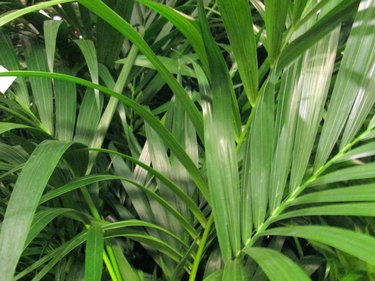
The areca palm (Dypsis lutescens), native to Madagascar and commonly referred to as a yellow butterfly palm or golden cane palm, belongs to the arecacea/palmae family and is one of the most used palms in outdoor landscaping in warm climates. It adds tropical flavor to any frost-free outdoor space in U.S. Department of Agriculture plant hardiness zones 9b through 11. While it doesn't require much pruning, trimming an areca palm plus a bit of routine maintenance will result in a far more attractive tree over the years.
Location in the Yard
Video of the Day
The areca is popular because it is inexpensive and requires low maintenance in terms of both light and water. The amount of trimming required will depend largely on where the areca is planted in the yard. In direct sunlight, the older leaves will yellow and even dry out to a gray mass of dead foliage. To minimize the amount of pruning necessary, keep the areca in a spot blessed with bright indirect light indoors or in a sheltered outdoor garden where it receives light or dappled shade in the afternoon.
Video of the Day
Age When Planted
The age of a palm is a factor when it's planted. A five- to six-year-old palm will handle direct sunlight well. There may be a slight increase in the yellowing of the leaves, but the plant will remain robust and healthy. When it's younger than five, though, the areca is far more sensitive to direct light, and placement in too intense a spot in the yard will result in yellowing of the fronds, which will necessitate more trimming and pruning to keep it attractive.
Culms and Trimming Areca Palm
As the areca palm ages and becomes larger, a great deal of foliage begins to accumulate around its culms, or stems. As with many palms, that foliage is at least partially dry and dead and, while no longer alive, will not be all that easy to remove. Professional pruning can cost as much as $300. However, you can avoid this entirely with a little bit of maintenance and trimming.
Trimming and Pruning
The trimming itself, if done regularly, is a relatively easy chore. Before you begin, put on safety goggles, gloves and other safety gear. Sterilize your cutting tools by dipping the blades in rubbing alcohol or Lysol.
Cut away any yellowing leaves near the base, and remove dry or dead foliage around the culms. If you're using the areca as a covering of sorts, whether along a fence, a back wall, or just to create a screen, remember that excessive pruning can leave gaps. Also keep this in mind when planting arecas and deciding how to space them in your yard. Arecas can be propagated by carefully removing rooted suckers at the base of the tree and replanting them.
Potential Problems and Areca Palms
If it's left to overgrow, the areca will be more time-consuming and difficult to prune. While it is most definitely a low maintenance plant, the areca will be most attractive when trimmed regularly. Also, given the areca's potential to grow to up to 30 feet high, there may come a time when trimming it is no longer possible without specialized equipment. The culms, of course, can always be maintained but when the palm has reached an unreachable height, hiring a professional every couple of years may be the best option.